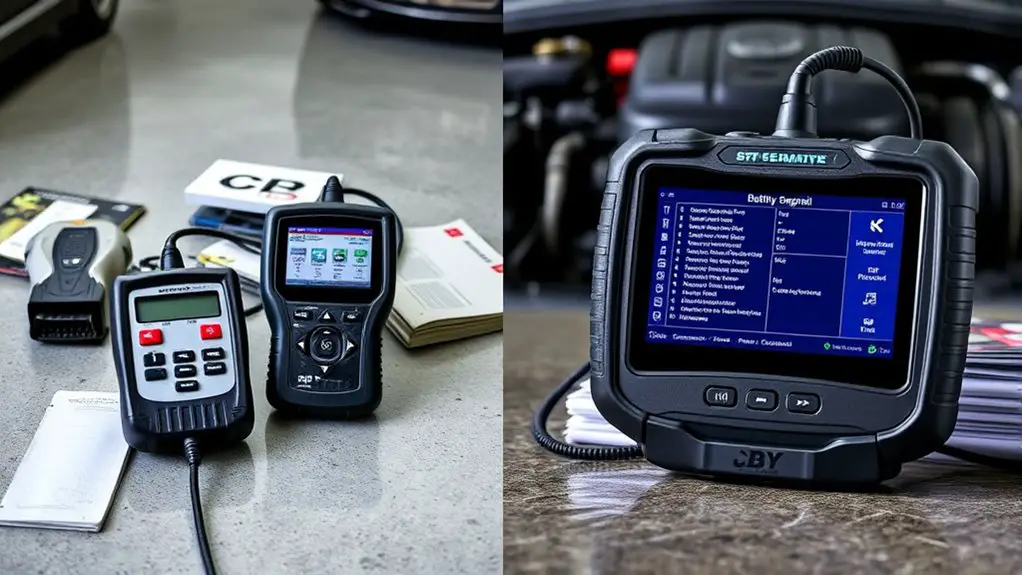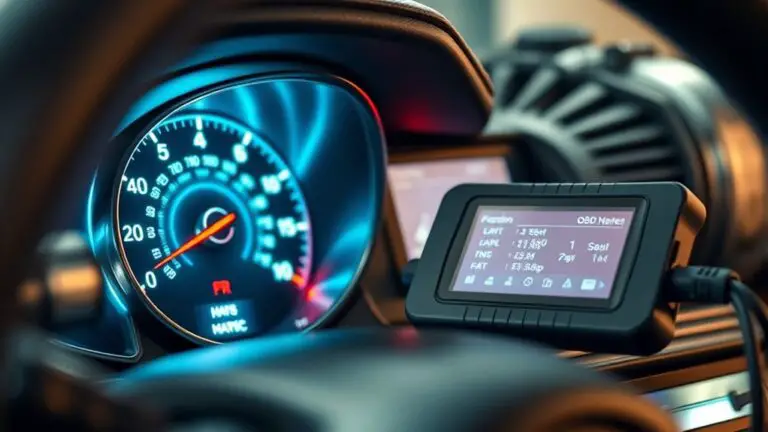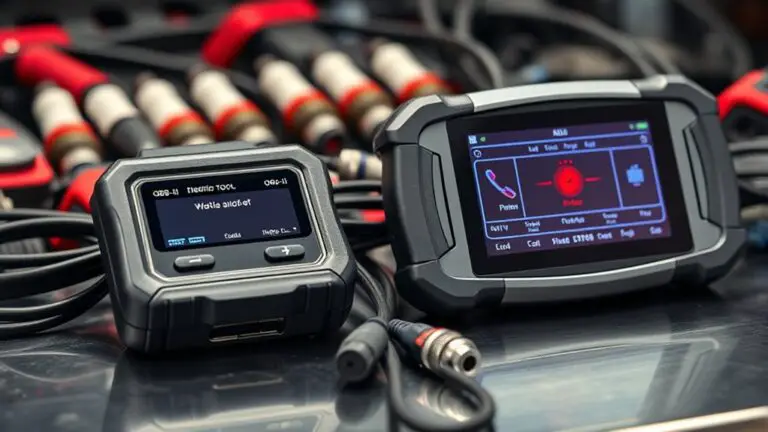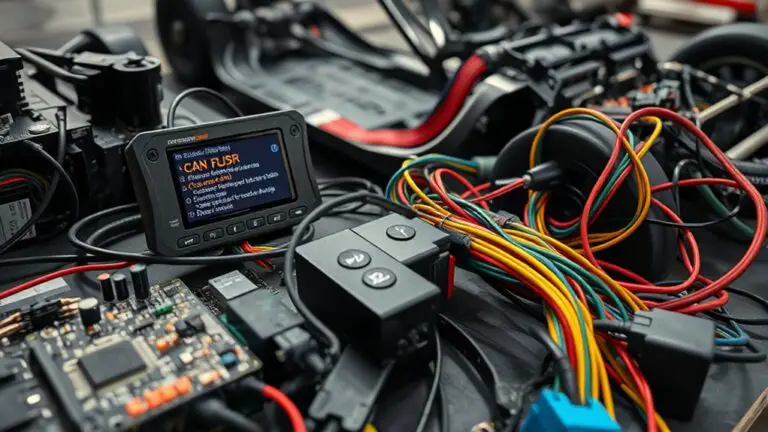Tool Comparison: Budget Vs Professional for Diagnosing Fault Codes Returning After Repair
When you’re choosing tools for fault codes that reappear after repair, consider reliability, data depth, and workflow impact. Budget tools are affordable and portable but may miss confirmations and drift between sessions. Professional diagnostics offer tighter consistency, richer data, and clear post-repair rules, though at higher cost. Expect frequent updates and brand-specific logic to guide after-repair checks. If you push for verifiable post-repair accuracy across brands, this choice matters—and more details will help you decide, step by step.
Budget Tools Overview: What You Get for the Price
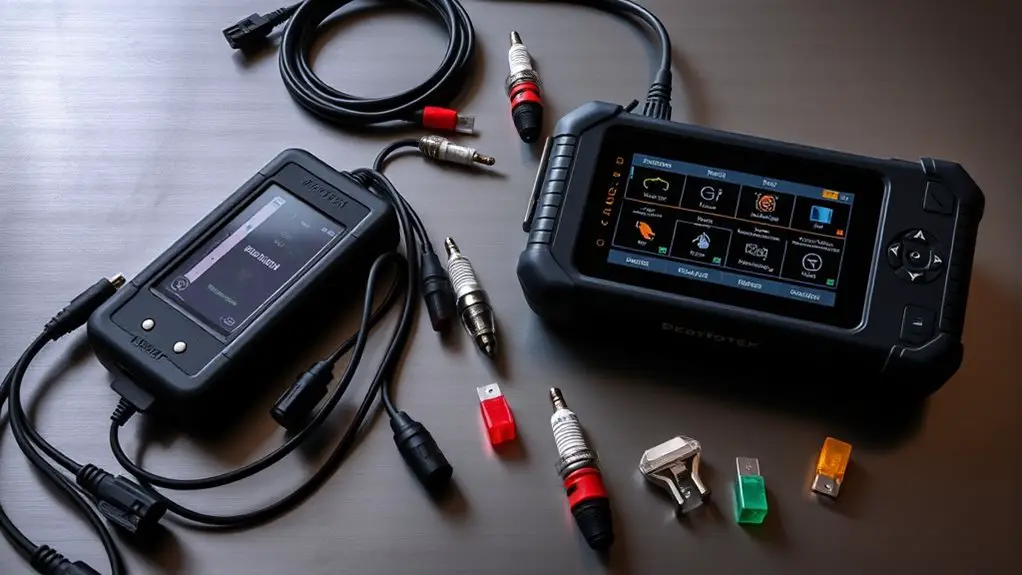
Budget tools deliver essential fault-code diagnosis without breaking the bank, providing core features like code reading, live data, and basic freezes/clear functions. You’ll find entry devices that cover common OBD-II codes and basic parameter monitoring, enough to verify faults without overpaying. Yet you’ll notice budget tool limitations: slower updates, limited sensor coverage, and fewer advanced modes. Diagnostic feature trade offs mean you trade depth for affordability—smarter fault localization often requires manual cross-checks or repeat scans, and generic interfaces may lack vehicle-specific codes. You should expect simplicity over sophistication, with concise dashboards and standardized data streams rather than granular analytics. Portability and user-friendliness stay strong selling points, helping you diagnose quickly and keep a project moving. If you’re prioritizing immediate access and freedom to test multiple vehicles, budget tools deliver reliable baseline insight—just stay aware of constraints that affect depth, accuracy, and long-term reliability.
Professional Diagnostics: Features That Matter Most
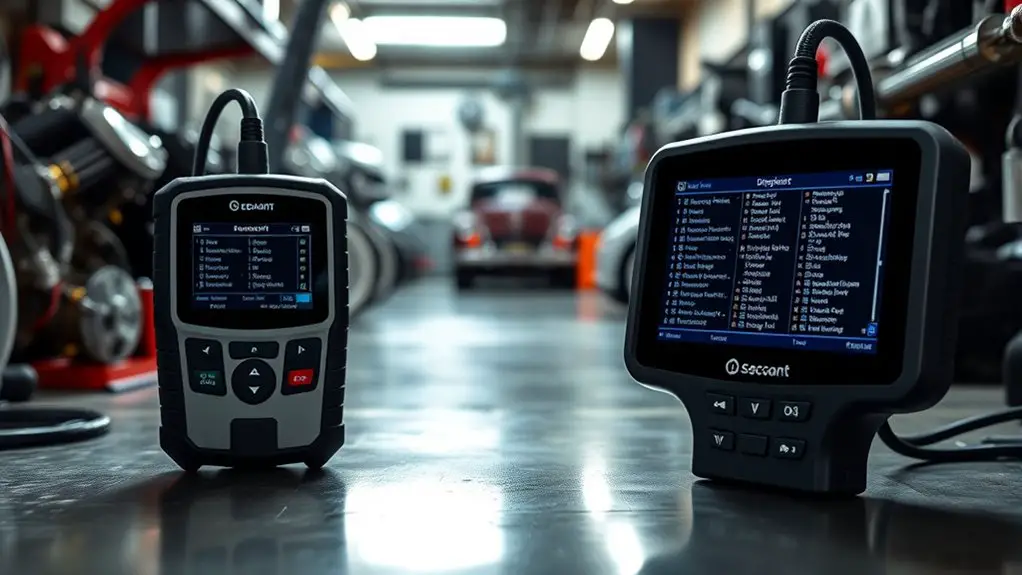
You’ll want tools that deliver clear Diagnostic Accuracy Metrics, so you can trust the fault codes you see. Real-Time Data Access keeps you current as you troubleshoot, reducing guesswork and rework. Focus on the workflow efficiency, since a streamlined process translates to faster, more reliable diagnostics.
Diagnostic Accuracy Metrics
Diagnostic accuracy metrics quantify how well diagnostic tools identify true fault codes and distinguish between benign readings and errors. You measure performance with concrete criteria and apply consistent tests to both budget and professional devices, ensuring you understand limits and confidence. Key concepts include diagnostic precision and accuracy evaluation, which guide tool selection for reliable repairs.
- Define true positives and false positives to map practical outcomes.
- Assess sensitivity to catch real faults without overcalling.
- Evaluate specificity to avoid misleading false alarms.
- Compare consistency across scenarios and repair contexts for robust decisions.
Adopt these metrics to determine value, reduce guesswork, and empower freedom in choosing tools that deliver trustworthy results, not just flashy displays. You’ll prioritize transparent metrics, repeatable protocols, and clear documentation above all.
Real-Time Data Access
Real-time data access is essential for professional diagnostics because it directly impacts how quickly and accurately you can identify faults. You gain instant visibility into sensor streams, fault codes, and live parameters, enabling decisive action rather than guesswork. With real-time tracking, you monitor trends as they unfold, catching intermittent issues before they become failures. Data visualization turns streams into actionable insights, letting you compare, filter, and annotate findings with confidence. The capability must be fast, reliable, and synchronized across tools so you aren’t chasing stale data. Below is a concise matrix of core access features.
| Access Type | Latency | Visualization Capabilities |
|---|---|---|
| Live streaming | Low | Graphs, gauges, dashboards |
Troubleshooting Workflow Efficiency
Efficient troubleshooting hinges on a streamlined workflow that prioritizes rapid access to relevant data, clear decision points, and repeatable steps. You’ll implement workflow optimization strategies that reduce latency between faultCode retrieval, interpretation, and action, while preserving diagnostic process improvement integrity.
- Establish data triage: filter noise, prioritize recent events, and surface authoritative codes.
- Define decision gates: lock in go/no-go criteria before any disassembly or replacement.
- Standardize steps: apply repeatable inspection, testing, and documentation across sessions.
- Measure outcomes: track time, accuracy, and success rate to drive continuous refinement.
This approach empowers you to diagnose faults efficiently, maintain autonomy, and pursue freedom through disciplined, precise tooling.
Fault-Code Return Reliability: Budget Vs Pro
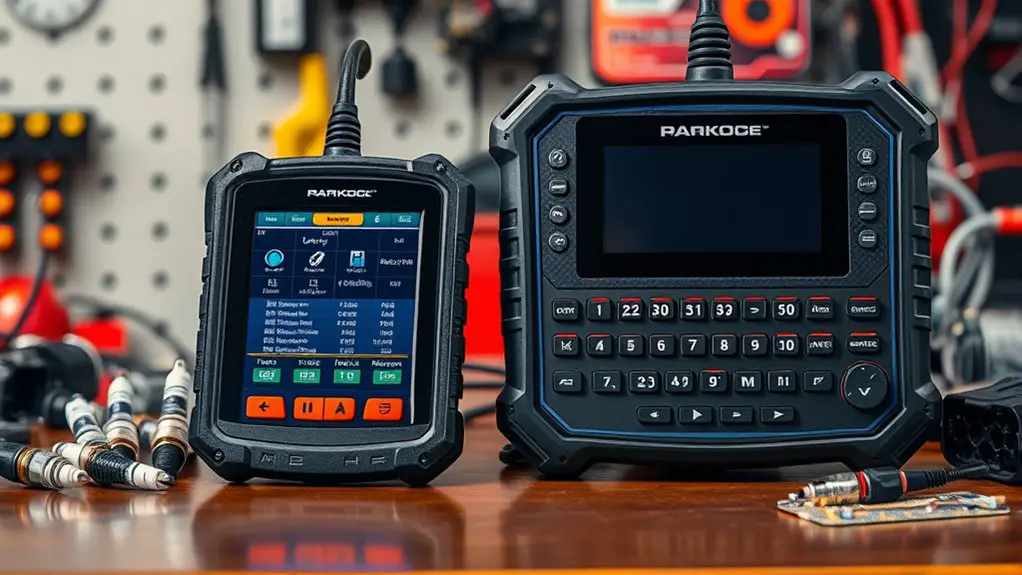
Budget features don’t guarantee reliability, so you should compare how budget tools perform under real-world fault-code loads. Pro-grade diagnostics typically show tighter consistency and fewer unexpected results, but you must weigh that against cost and workflow impact. Expect to see differences in return-code variability across budgets, with Pro solutions offering more predictable outputs and fewer false negatives.
Budget Diagnostics Reliability
When evaluating fault-code return reliability, budget diagnostic tools generally deliver fewer confirmations and more occasional misses than their Pro counterparts, though they can be dependable for straightforward issues. You’ll see consistency gaps under complex faults, but basic diagnostics stay usable.
1) Budget tool reliability hinges on core sensor reads and code presence.
2) Diagnostic tool performance improves with frequent updates and calibration.
3) Expect longer verification times for ambiguous codes.
4) Prioritize redundancy: cross-check results with a second tool when uncertainty arises.
Approach: quantify misses vs confirmations, log every return, and compare against service records. This disciplined method helps you gauge risk, allocate testing time, and decide when to escalate to professional-grade diagnostics without overinvesting.
Pro Diagnostic Consistency
In this section, we compare fault-code return reliability between budget and Pro diagnostic tools, focusing on consistency of results when diagnosing faults. You’ll assess diagnostic reliability by tracking identical fault scenarios across multiple sessions, vehicles, and firmware builds. Pro tools typically deliver tighter result convergence, thanks to curated software baselines, robust data libraries, and validated sensor mappings. Budget devices may exhibit occasional drift, yet can remain practical for repeated, straightforward faults if kept up to date. For you, consistency translates into fewer false positives, quicker confirmation cycles, and clearer repair decisions. Consider tool longevity as a factor: Pro units often endure harsher use, with longer support lifecycles and durable hardware. Informed choices here enhance diagnostic reliability and overall tool longevity.
Return Code Variability
Variability in return codes reflects how consistently diagnostic tools interpret fault scenarios across sessions, vehicles, and firmware. You’ll notice that return code patterns differ between budget and professional gear, revealing diagnostic inconsistencies you can’t ignore. To keep decisions solid, evaluate reliability across environments, not just on a single vehicle.
- Compare return code patterns across multiple sessions to identify stable signals vs noise.
- Track how firmware revisions affect code interpretation and resolution guidance.
- Assess cross-brand tool agreement on common faults to gauge portability.
- Measure the impact of sensor health and wiring quality on code consistency.
This approach clarifies where tools fail, guiding you toward trustworthy diagnostics and preserving the freedom to diagnose with confidence.
Data Depth and Access: PIDs, Codes, and Live Readouts
Data depth and access determine how effectively you diagnose faults: you must understand which PIDs you can read, what codes you’ll encounter, and how live readouts reflect real-time conditions. In practice, PID accessibility shapes your diagnostic edge: knowing which PIDs are supported by your tool, vehicle, and protocol lets you prioritize data that clarifies fault causation. Codes, including pending and confirmed fault codes, reveal failure timing and persistence, so you read them with context, not as standalone signals. Live data informs trend analysis, throttle position, temps, and sensor dynamics that confirm or dismiss suspected faults. You’ll compare tools by the breadth of PID coverage, the clarity of parameter names, and the refresh rate of live data streams. Prioritize robust filtering, labeling, and export options so you can build repeatable diagnostic workflows. The result is disciplined insight, not guesswork, enabling precise repair decisions while preserving your freedom to tackle challenges. live data, PID accessibility.
Update Cadence and Support: Keeping up With Vehicles
Keeping pace with vehicle updates matters because software and protocol changes drive tool compatibility and data availability. You’ll want a plan that tracks update cadence, not just the tool price, because update frequency determines whether you can read codes promptly and access current data definitions. A disciplined approach keeps your workflow stable and your results reliable.
Key points to follow:
1) Monitor update cadence from the vendor and hardware partners to align support windows.
2) Favor tools with transparent release notes that map to vehicle compatibility across eras.
3) Validate critical modules after each notable update to guarantee consistent fault-code interpretations.
4) Maintain a rollback or test environment to compare pre- and post-update behavior without risking production work.
In practice, prioritize ongoing support and timely patches, because vehicle compatibility hinges on how quickly updates arrive and how clearly they document changes. You gain reliability when update frequency aligns with your diagnostic needs.
Real-World Scenarios: After-Repair Codes Across Brands
After-repair codes often surprise shop floors because different brands implement fault indication and clearing rules in distinct ways; understanding these nuances helps guarantee consistent results across platforms. In real-world scenarios, you’ll encounter after repair codes that don’t always align with the repair you performed. You must map each code to the specific brand logic—some brands require a complete drive cycle, others rely on the number of key cycles or tolerance checks. Expect brand specific issues to surface when customers report intermittent symptoms after a repair, or when a code reappears after a brief reset. Your approach should be disciplined: verify the fault code history, confirm the exact clearing criteria, and test the system under representative load conditions. Document the sequence, capture any nonstandard indications, and differentiate service advisories from actual faults. This discipline prevents misdiagnosis and supports reliable outcomes across diverse after repair scenarios.
Ease of Use and Workflow Impact
Ease of use and workflow impact start with how intuitively you can apply the brand-specific logic discussed earlier. You’ll measure how quickly fault codes map to actionable steps and whether prompts align with your repair routine. The goal is clear, repeatable results, not guesswork, so you’ll value user friendliness and smooth workflow integration above novelty.
- Clear navigation and unambiguous prompts that minimize keystrokes and clicks.
- Consistent terminology across dashboards, reports, and diagnostic steps.
- Real-time guidance that aligns with your repair sequence without forcing back-and-forth.
- Seamless data export and integration with your existing tooling.
This approach favors freedom by removing friction, enabling you to adopt either budget or professional tools without rewiring your process. Expect predictable interactions, quicker validation of repair conclusions, and fewer misreads from ambiguous codes. In practice, choose the option that preserves a lean, efficient workflow while keeping user friendliness at the core.
Total Cost of Ownership: Upfront Vs Long-Term Value
When evaluating total cost of ownership, you must balance upfront expenditures against long-term value, since initial price often signals only part of the picture. In this section, you’ll weigh upfront costs against the durability, reliability, and maintenance demands of budget versus professional tools. Consider lifecycle cost: higher upfront may yield lower downtime, fewer repairs, and steadier performance under fault-code diagnostics. Factor software subscriptions, updates, and license tenure as part of the long term investment, not just a one-off price. Assess spare parts availability, service response times, and training needs, since these drive total ownership. A tool’s resale value and compatibility with future vehicles influence long term investment as well. Your goal is a predictable cost curve: clear payback horizon, known depreciation, and consistent diagnostic capability. By framing decisions around total cost of ownership, you align budget choices with strategic freedom and sustained diagnostic efficacy, beyond immediate sticker shock.
Practical Tips for Choosing Between Budget and Professional Tools
Choosing between budget and professional tools isn’t just about price tag—it’s about reliability under real-world fault-code diagnostics. To decide, assess core capabilities, supported interfaces, and update cadence. You want tools that translate data into actionable faults, not noise.
Key considerations:
- budget tool advantages are clear upfront cost and sufficient basics for common codes.
- professional tool drawbacks include higher cost, longer procurement cycles, and potential feature overkill.
- expandability matters: guarantee hardware and software can grow with new vehicle protocols.
- validation: confirm you can reproduce faults with consistent results before trusting any diagnosis.
Tips to apply now:
- prioritize diagnostic coverage over sheer speed.
- map each tool’s supported brands to your workshop mix.
- check update policies and support responsiveness.
- test real-world fault codes after repair to verify stability.
If you value freedom, choose a tool that balances affordability with dependable, repeatable data—without sacrificing essential accuracy. Budget tool advantages, professional tool drawbacks.
Frequently Asked Questions
Can Budget Tools Detect All Oem-Specific Fault Codes?
Yes, budget tools won’t detect all OEM-specific fault codes. You’ll see gaps in OEM compatibility and limited fault code coverage compared to professional scanners. If you value precision, expect missed codes, slower vehicle coverage, and more guesswork. For reliability, prioritize tools that explicitly state OEM compatibility for your makes, and verify coverage for safety-critical modules. In short, budget options may suffice for basics, but they’re not a complete substitute for thorough diagnostics.
Do Professional Tools Offer Better Support for Reflashable ECUS?
Yes, professional tools offer better support for reflashable ECUs. You’ll gain access to professional features like advanced BIOS-level access, official reflash routines, and vendor-specific firmware libraries, which improve diagnostic accuracy. You’ll also benefit from validated procedures and direct support channels, reducing risk during flashes. This equips you to approach reflashes with confidence, blending technical precision with the freedom to push thresholds while maintaining reliability.
How Often Do Budget Tools Lose Data After Resets?
Budget tools can lose data after resets in a non-negligible minority of cases, though frequency varies by model. You should expect occasional data retention issues if you don’t back up before resets. Tool reliability improves with reputable brands and regular firmware updates. To maintain data integrity, perform frequent backups, verify stored records, and track calibration logs. This approach preserves data retention and supports confident diagnostics when you need to recheck fault codes after repairs.
Are There Safety Risks Using Budget Tools on Modern Vehicles?
Yes, there are safety risks if you misuse budget tools on modern vehicles. You could trigger unintended changes or misread critical codes, compromising safety features like airbags or stability control. However, when you verify data with reputable sources and avoid invasive edits, you can maintain diagnostic accuracy. Use tools that provide clear fault-code definitions, proper reinitialization, and safety warnings, and always cross-check with OEM guidelines for a disciplined, freedom-minded approach.
Do Professional Tools Require Ongoing Subscription Costs?
Yes, professional tools often require ongoing subscription costs. You’ll see subscription models tied to updates, cloud data, and advanced support, which affects tool longevity through ongoing access and reliability. You’ll want to budget for these recurring fees even as you invest in durable hardware. If you value freedom, plan for a mix: solid core tools plus selective upgrades, ensuring long-term diagnostic capabilities without surrendering independence.

